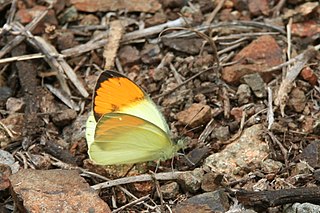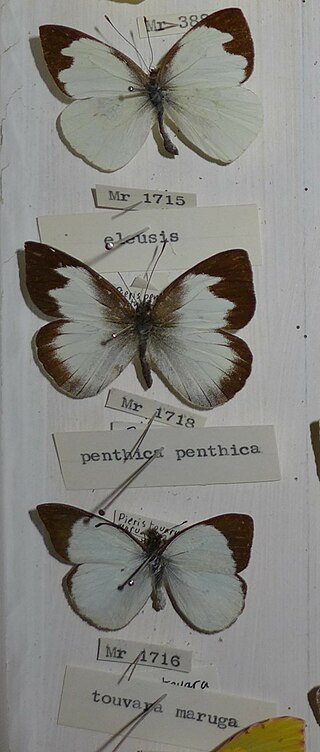
The Pierinae are a large subfamily of pierid butterflies. The subfamily is one of several clades of butterflies often referred to as the whites.

The tribe Anthocharini is one of the subdivisions of the insect order Lepidoptera, which includes the moths and butterflies. It is a further subdivision of the butterfly family Pieridae and subfamily Pierinae; formerly it was considered a subfamily on its own, Anthocharinae. This tribe includes many, but not all, of the orangetip butterflies.

Anthocharis is a holarctic genus of the butterfly tribe Anthocharini, in the family Pieridae. These are typically small, white-hued butterflies that have colorful marks just inside the tips of the forewings. The tip colors are usually a red-orange hue, hence the name "orange tip". The larvae of these butterfly often consume cruciferous plants containing chemicals called glucosinolates. This genus is characterized by two of the five subcostal veins branching off before the apex of the cell, by the upper radial being only little united with the subcostal, and by the central discocellular being rather long. In all the species the males have at least the apical portion of the forewing orange red or yellow. Only one species inhabits also the northern districts of the Palearctic region, all the others are found in the south of the Palearctic region, also some species occur in North America, but not one species extends into the tropics. The Anthocharis species have only one brood. The butterflies occur in spring.

Biturix is a genus of moths in the subfamily Arctiinae.

Philotes is a genus of butterflies in the family Lycaenidae. Philotes is a monotypic genus containing only Philotes sonorensis, the Sonoran blue or stonecrop blue, found in North America in California and Baja California. The habitat consists of rocky washes, outcrops and cliffs in deserts.

Acronicta lobeliae, the lobelia dagger moth or greater oak dagger moth, is a moth of the family Noctuidae. The species was first described by Achille Guenée in 1852. It is found in North America.

Amyna is a genus of moths of the family Noctuidae erected by Achille Guenée in 1852.
Conicophoria is a monotypic moth genus of the family Noctuidae. Its only species, Conicophoria formosana, is found in Taiwan. Both the genus and species were first described by Shōnen Matsumura in 1929.

Isogona is a genus of moths of the family Erebidae. The genus was erected by Achille Guenée in 1852.

Pandesma is a genus of moths in the family Erebidae. The genus was erected by Achille Guenée in 1852.

Platyja is a genus of moths of the family Erebidae erected by Jacob Hübner in 1823.

Colotis auxo, the yellow orange tip or sulphur orange tip, is a butterfly of the family Pieridae. The species was first described by Hippolyte Lucas in 1852. It is found in southern Africa and is named after the Keiskamma River.

Acronicta lepusculina, commonly known as the cottonwood dagger moth, is a species of moth in the family Noctuidae. The species was first described by Achille Guenée in 1852. It is found in most of eastern North America, west through southern Canada to Vancouver Island and southward.

Colotis celimene, the lilac tip or magenta tip, is a butterfly of the family Pieridae. The species was first described by Hippolyte Lucas in 1852. It is found in the Afrotropical realm.

Elina is a genus of butterflies in the family Nymphalidae erected by Émile Blanchard in 1852. It is found in Chile.

Catasticta is a genus of Neotropical butterflies in the family Pieridae. The genus was erected by Arthur Gardiner Butler in 1870.

Leptophobia eleusis, the Eleusis white, is a butterfly in the family Pieridae. The species was first described by Hippolyte Lucas in 1852. It is found from Venezuela to Bolivia.

Dismorphia lewyi is a butterfly in the family Pieridae first described by Hippolyte Lucas in 1852. It is found from Venezuela to Bolivia.

Euploea boisduvali, is a butterfly in the family Nymphalidae. It was described by Hippolyte Lucas in 1852. It is found in the Australasian realm


















